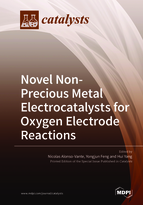Novel Non-Precious Metal Electrocatalysts for Oxygen Electrode Reactions
A special issue of Catalysts (ISSN 2073-4344). This special issue belongs to the section "Electrocatalysis".
Deadline for manuscript submissions: closed (30 September 2018) | Viewed by 68554
Special Issue Editors
Interests: electrochemistry; photoelectrochemistry; ORR-, HER-, OER-electrocatalysis; energy and fuels; nanomaterials; micro-fuel cells
Special Issues, Collections and Topics in MDPI journals
Interests: non-platinum metal electrocatalysts; oxygen reduction reaction (ORR); oxygen evolution reaction (OER); multifunctional layered nanomaterials; layered double hydroxides (LDHs); high-performance adsorption materials; removal of heavy metals and phosphate
Special Issues, Collections and Topics in MDPI journals
Interests: Pt-based electrocatalysts for fuel cells’ reaction non-precious metal catalyst for hydrogen oxidation and oxygen reduction reactions; new proton exchange membrane with high stability; direct methanol fuel cells; energy storage materials
Special Issue Information
Dear Colleagues,
Increasing inevitable global demands for energy have stimulated considerable research on alternative energy harvesting technologies, conversion and storage systems with high efficiency, cost-effective and environmentally friendly systems, such as fuel cells, rechargeable metal-air batteries, unitized regenerative cells, and water electrolyzers. In these devices, the conversion between oxygen and water plays a key step in the development of oxygen electrodes: Oxygen reduction reaction (ORR) and oxygen evolution reaction (OER). To date, the state-of-art catalysts for ORR consist of platinum-based materials (Pt), while ruthenium (Ru)- and iridium (Ir)-oxides are the best-known OER catalyst materials. The scarcity of precious metals, their prohibitive cost, and declining activity greatly hamper the practice for large-scale applications. It is of paramount practical importance and interest to develop efficient and stable materials for the oxygen electrode, based on Earth-abundant non-noble metals. With the fast development of advanced nanotechnology, novel non-precious metal electrocatalysts for the oxygen reactions have been explored based on the innovative design in chemical compositions, structure, and morphology, and supports.
This Special Issue aims to cover recent progress and advances in novel non-precious metal electrocatalysts tailoring with high activity and stablity for the catalytic conversion between water and oxygen. Additionally, electrocatalytic activity, selectivity, durability, and mechanism for single or bifunctional oxygen electrode reactions should be important subjects for this Special Issue.
Prof. Dr. Nicolas Alonso-Vante
Prof. Dr. Yongjun Feng
Prof. Dr. Hui Yang
Guest Editors
Manuscript Submission Information
Manuscripts should be submitted online at www.mdpi.com by registering and logging in to this website. Once you are registered, click here to go to the submission form. Manuscripts can be submitted until the deadline. All submissions that pass pre-check are peer-reviewed. Accepted papers will be published continuously in the journal (as soon as accepted) and will be listed together on the special issue website. Research articles, review articles as well as short communications are invited. For planned papers, a title and short abstract (about 100 words) can be sent to the Editorial Office for announcement on this website.
Submitted manuscripts should not have been published previously, nor be under consideration for publication elsewhere (except conference proceedings papers). All manuscripts are thoroughly refereed through a single-blind peer-review process. A guide for authors and other relevant information for submission of manuscripts is available on the Instructions for Authors page. Catalysts is an international peer-reviewed open access monthly journal published by MDPI.
Please visit the Instructions for Authors page before submitting a manuscript. The Article Processing Charge (APC) for publication in this open access journal is 2700 CHF (Swiss Francs). Submitted papers should be well formatted and use good English. Authors may use MDPI's English editing service prior to publication or during author revisions.
Keywords
- Non-precious metal electrocatalysts
- oxygen reduction reaction
- oxygen evolution reaction
- bifunctional electrocatalysts
- electrocatalytic activity
- electrocatalytic selectivity
- electrocatalytic durability, unitizes fuel cells.








